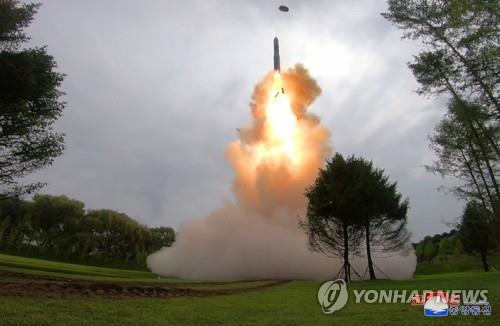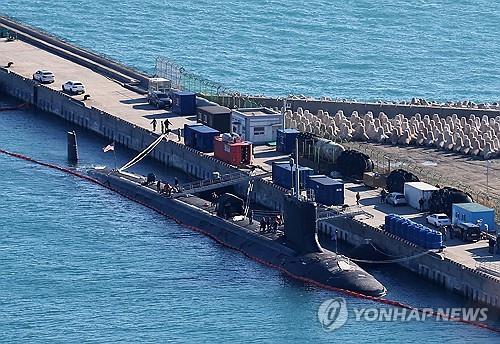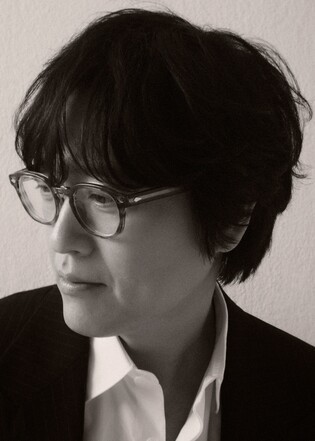 |
| ▲ North Korea fires a Hwasong-18 solid-fuel intercontinental ballistic missile (ICBM) on July 12, 2023, in this photo released by the North's official Korean Central News Agency. North Korean leader Kim Jong-un guided the launch, and the missile flew 1,001 kilometers for 4,491 seconds at a maximum altitude of 6,648 km before splashing into the East Sea, the North said. (For Use Only in the Republic of Korea. No Redistribution) (Yonhap) |
 |
| ▲ The U.S. nuclear-powered submarine USS Missouri arrives at a key naval base in Busan, 320 kilometers southeast of Seoul, on Dec. 17, 2023. (Yonhap) |
(News Focus) NK-ICBM launch
(News Focus) N. Korea launches ICBM in show of force as S. Korea, U.S. upgrade nuclear strategy
By Kim Eun-jung
SEOUL, Dec. 18 (Yonhap) -- North Korea ratcheted up tension with the latest launch of its intercontinental ballistic missile (ICBM) Monday in a fresh show of force after South Korea and the United States held talks on deterring Pyongyang's growing nuclear threats, experts said.
North Korea fired a long-range missile from the Pyongyang area at 8:24 a.m., the Joint Chiefs of Staff (JCS) said, in less than a day after it launched a short-range ballistic missile from the capital Sunday night.
The ICBM was fired at a lofted angle and flew about 1,000 kilometers before falling into the East Sea, the JCS said, without providing further details.
Shingo Miyake, Japanese parliamentary vice minister of defense, said the ICBM is estimated to have flown for 73 minutes with a maximum altitude of more than 6,000 km, which is similar to the flight time and trajectory of the solid-fuel Hwasong-18 ICBM launched in July.
It marks North Korea's fifth ICBM test this year, including two test-firings of Hwasong-18 ICBMs each in April and July as well as Hwasong-15 and Hwasong-17 ICBMs launched in February and March, respectively.
Observers say the North may have fired the latest missile in a clear show of force against South Korea and the U.S., considering it came just days after the allies held the second session of the Nuclear Consultative Group (NCG).
During the talks, South Korea and the U.S. agreed to complete the establishment of guidelines on a shared nuclear strategy by the middle of next year and conduct joint military exercises simulating nuclear attacks from the North.
The back-to-back missile launches also came as the U.S. nuclear-powered submarine USS Missouri has been docked at a key naval base in Busan, 320 kilometers southeast of Seoul, since Sunday.
"As the ICBM was launched shortly after the NCG meeting, it demonstrates the North's strong will to confront South Korea and the U.S. with a purpose of claiming its initiative in matters on the Korean Peninsula," Yang Moo-jin, a president of the University of North Korean Studies in South Korea, said.
"The North is expected to continue its show of force until the U.S. nuclear-powered submarine leaves South Korea," Yang added.
The latest missile launch comes after Pyongyang placed its first spy satellite into orbit on Nov. 21, following two failed attempts in May and August, respectively.
Seoul and Washington have condemned Pyongyang's ICBM tests and satellite launch as violations of multiple U.N. Security Council resolutions that ban the use of its ballistic missile technology.
If fired on a normal trajectory, it would have flown about 12,000-15,000 km, long enough to strike the U.S. mainland, experts said.
A solid-fuel missile poses a major security challenge to South Korea and the U.S. given its shorter fueling time, which could make it harder to detect and intercept with a preemptive strike system.
The challenge will be compounded if the North's spy satellite normally operates, as it could enhance its precision strike capability of major targets of South Korean and U.S. troops.
Pyongyang claims its spy satellite launch was a success, but its surveillance capability is considered rudimentary for the global standard.
Experts say the Kim Jong-un regime may have aimed at boosting internal unity with the ICBM launch ahead of the ninth plenary meeting of the eighth Central Committee of the ruling Workers' Party later this month, which is expected to discuss this year's state policies and policy goals for next year.
North Korea has been doubling down on its missile program this year, designating Nov. 18 as "missile industry day," when leader Kim Jong-un oversaw the test-firing of the Hwasong-17 ICBM with his daughter, Ju-ae, last year.
"As South Korea and the U.S. have agreed to jointly carry out nuclear exercises starting next year and continued to deploy strategic assets, North Korea is actively responding to their move, using it as a pretext," said Hong Min, a senior research fellow at the state-run Korea Institute for National Unification. "The North is demonstrating its determination for a proactive offensive ahead of the party meeting."
Tension remains high on the Korean Peninsula after North Korea vowed to restore all military measures halted under a 2018 inter-Korean military accord, reinstalling guard posts and deploying heavy arms within the Demilitarized Zone that separates the two Koreas.
The agreement signed under former liberal President Moon Jae-in set up buffer zones in land, sea and air and banned live-fire drills near the border.
The North's move came after South Korea partially suspended the pact and resumed aerial surveillance near the border in protest of the North's spy satellite launch last month.
Looking ahead to next year, observers express concerns over North Korea's possible heightening of provocations ahead of the U.S. presidential election slated for November 2024.
"North Korea is expected to stage high-intensity provocations targeted at the U.S. next year with the intention of drawing nuclear disarmament talks under a nuclear power status," Yang said.
North Korea conducted its sixth and last nuclear test in September 2017, and enshrined its nuclear power status in its constitution in September. Nuclear negotiations between Washington and Pyongyang remain stalled since the 2019 Hanoi summit between Kim and then U.S. President Donald Trump ended without a deal.
(END)
(C) Yonhap News Agency. All Rights Reserved




















![[가요소식] 조항조, 새 싱글](/news/data/20251116/yna1065624915927473_582_h2.jpg)










